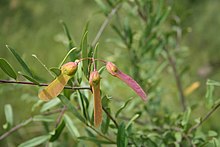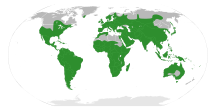| Polygalaceae | |
|---|---|

| |
| Securidaca longipedunculata | |
| Scientific classification | |
| Kingdom: | Plantae |
| Clade: | Tracheophytes |
| Clade: | Angiosperms |
| Clade: | Eudicots |
| Clade: | Rosids |
| Order: | Fabales |
| Family: | Polygalaceae Hoffmanns. & Link[1] |
| Type genus | |
| Polygala | |
| Tribes | |

| |
| Distribution of the Polygalaceae | |
| Synonyms | |
| |
The Polygalaceae or the milkwort family are made up of flowering plants in the order Fabales. They have a near-cosmopolitan range, with about 27 genera and ca. 900 known species[2] of herbs, shrubs and trees. Over half of the species are in one genus, Polygala, the milkworts.
The family was first described in 1809 by Johann Hoffmansegg and Johann Link.[3] In 1896, Robert Chodat split it into 3 tribes. A fourth tribe was split off from the tribe Polygaleae in 1992.[4] Under the Cronquist classification system, Polygalaceae were treated in a separate order of their own, Polygalales. Currently, according to the Angiosperm Phylogeny Group, the family belongs in Fabales.
Description
[edit]Polygalaceae are annual or perennial herbs, shrubs, trees or lianas.[5] Its zygomorphic, hermaphrodite, bisexual flowers have 3-5 petals and 5 sepals.[6][7] Its leaves are usually alternate, but may be opposite, fascicled, or verticillate.[6] Each flower usually contains 8 stamens, though this may range from 3 to 10. They are usually in 2 series.[7] The fruits of each plant can be a capsule, samara, or drupe.[6]
Tribes and genera
[edit]The Polygalaceae comprise the following genera,[6] with tribes based on various sources.[8][9][10][11][12][13]
- Carpolobieae Eriksen
- Atroxima Stapf
- Carpolobia G. Don
- Moutabeae Chodat
- Barnhartia Gleason
- Diclidanthera Mart.
- Eriandra P. Royen & Steenis
- Moutabea Aubl.
- Polygaleae Chodat
- Acanthocladus Klotzsch ex Hassk.
- Ancylotropis B.Eriksen
- Asemeia Raf.
- Badiera DC.
- Bredemeyera Willd.
- Caamembeca J.F.B. Pastore
- Comesperma Labill.
- Epirixanthes Blume
- Gymnospora (Chodat) J.F.B.Pastore
- Hebecarpa (Chodat) J.R.Abbott
- Heterosamara Kuntze
- Hualania Phil.
- Monnina Ruiz & Pav.
- Monrosia Grondona
- Muraltia DC.
- Phlebotaenia Griseb.
- Polygala L.
- Polygaloides Haller
- Rhamphopetalum J.F.B.Pastore & M.Mota
- Rhinotropis (S.F. Blake) J.R. Abbott
- Salomonia Lour.
- Securidaca L.
- Xanthophylleae Chodat
- Xanthophyllum Roxb.
- Tribe not assigned
- Senega (DC.) Spach
Fossils
[edit]- †Deviacer Manchester
- †Paleosecuridaca Pigg, Kathleen B., M.L. DeVore & M.F. Wojc. 2008
Systematics
[edit]Modern molecular phylogenetics suggest the following relationships:[13][14][15][16][17][18]
| ||||||||||||||||||||||||||||||||||||||||||||||||||||||||||||||||||||||||||||||||||||||||
References
[edit]- ^ Angiosperm Phylogeny Group (2009). "An update of the Angiosperm Phylogeny Group classification for the orders and families of flowering plants: APG III" (PDF). Botanical Journal of the Linnean Society. 161 (2): 105–121. doi:10.1111/j.1095-8339.2009.00996.x. hdl:10654/18083. Retrieved 2013-07-06.
- ^ Christenhusz, M. J. M. & Byng, J. W. (2016). "The number of known plants species in the world and its annual increase". Phytotaxa. 261 (3): 201–217. doi:10.11646/phytotaxa.261.3.1.
- ^ Harvard University; Royal Botanic Gardens Kew; Australian National Herbarium. "Polygalaceae". International Plant Names Index. Retrieved July 16, 2020.
- ^ Eriksen, Bente (1993). "Phylogeny of the Polygalaceae and its taxonomic implications". Plant Systematics and Evolution. 186 (1/2): 33–55. doi:10.1007/BF00937712. ISSN 0378-2697. JSTOR 23674643. S2CID 32590790.
- ^ Messina, Andre (2022). Kodela, P.G. (ed.). "Polygalaceae Hoffmanns. & Link". Flora of Australia. Australian Biological Resources Study, Department of Climate Change, Energy, the Environment and Water: Canberra. Retrieved 15 April 2024.
- ^ a b c d "Polygalaceae Hoffmanns. & Link". Plants of the World Online. Royal Botanic Gardens, Kew. Retrieved 23 July 2024.
- ^ a b "Polygalaceae". Flora of Victoria. Government of Victoria, Australia. Retrieved July 16, 2020.
- ^ Abbott JR. (2011). "Notes on the disintegration of Polygala (Polygalaceae), with four new genera for the flora of North America". Journal of the Botanical Research Institute of Texas. 5 (1): 125–137. JSTOR 41972495.
- ^ Pastore JFB. (2012). "Caamembeca: Generic status and new name for Polygala subgenus Ligustrina (Polygalaceae)". Kew Bull. 67 (3): 435–442. doi:10.1007/s12225-012-9360-x. S2CID 19252598.
- ^ Pastore JF, Rodrigues de Moraes PL (2013). "Generic status and lectotypifications for Gymnospora (Polygalaceae)". Novon. 22 (3): 304–306. doi:10.3417/2010113. S2CID 85269764.
- ^ Abbott JR, Pastore JF (2015). "Preliminary synopsis of the genus Hebecarpa (Polygalaceae)". Kew Bull. 70 (3): 39. doi:10.1007/s12225-015-9589-2. S2CID 22601207.
- ^ Freire-Fierro A. (2015). Systematics of Monnina (Polygalaceae) (Ph.D.). Drexel University. Archived from the original on 2017-03-19. Retrieved 2017-03-19.
- ^ a b Pastore JF, Abbott JR, Neubig KM, Whitten WM, Mascarenhas RB, Almeida Mota MC, van den Berg C (2017). "A molecular phylogeny and taxonomic notes in Caamembeca (Polygalaceae)". Syst Bot. 42 (1): 54–62. doi:10.1600/036364417X694935. S2CID 90353852.
- ^ Persson C. (2001). "Phylogenetic relationships in Polygalaceae based on plastid DNA sequences from the trnL–F region". Taxon. 50 (3 (Golden Jubilee Part 5)): 763–779. doi:10.2307/1223706. JSTOR 1223706.
- ^ Forest F, Chase MW, Persson C, Crane PR, Hawkins JA (2007). "The role of biotic and abiotic factors in evolution of ant dispersal in the milkwort family (Polygalaceae)". Evolution. 61 (7): 1675–1694. doi:10.1111/j.1558-5646.2007.00138.x. PMID 17598748. S2CID 37523521.
- ^ Bello MA, Bruneau A, Forest F, Hawkins JA (2009). "Elusive relationships within order Fabales: Phylogenetic analyses using matK and rbcL sequence data". Syst Bot. 34 (1): 102–114. doi:10.1600/036364409787602348. S2CID 85655712.
- ^ Abbott JR. (2009). Phylogeny of the Polygalaceae and a revision of Badiera (PDF) (Ph.D.). University of Florida.
- ^ Mennes CB, Moerland MS, Rath M, Smets EF, Merckx VS (2015). "Evolution of mycoheterotrophy in Polygalaceae: The case of Epirixanthes". Am J Bot. 102 (4): 598–608. doi:10.3732/ajb.1400549. PMID 25878092.